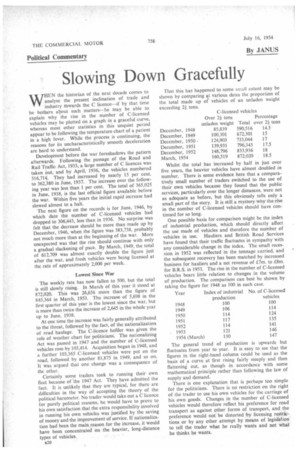Slowing Down Gracefully
Page 54

If you've noticed an error in this article please click here to report it so we can fix it.
WHEN the historian of the next decade comes to analyse the present inclination of trade and industry towards the C licence—if by that time he bothers ahout such matters—he may be able to explain why the rise in the number of C-licensed vehicles may be plotted on a graph in a graceful curve, whereas most other statiStics in this unquiet period appear to be following the temperature chart of a patient in a high fever. While the process is continuing, the reasons for its uncharacteristically smooth deceleration are hard to understand.
Development before the war foreshadows the pattern afterwards. Following the passage of the Road and Rail Traffic Act, 1933, a large number of C licences was taken out, and by April, 1936, the vehicles numbered 316,714. They had increased by nearly 15 per cent. to 362,380 in June, 1937. The increase over the following year was less than 1 per cent. The total of 365,025 in June, 1938, is the last official figure available before the war. Within five years the initial rapid increase had slowed almost to a halt.
The next figure on the records is for June, 1946, by which date the number of C-licensed vehicles had dropped to 306,443, less than in 1936. No surprise was felt that the decrease should be more than made up by December, 1946, when the figure was 383,738, probably not much more than at the beginning of the war. More unexpected was that the rise should continue with only a gradual slackening of pace. By March, 1949, the total of 612,709 was almost exactly double the figure just after the war, and fresh vehicles were being licensed at the rate of approximately 2,000 per week.
Lowest Since War The weekly rate has now fallen to 500, but the total is still slowly rising. In March of this year it stood at 872,020. This was 26,656 more than the figure of 845,364 in March, 1953. The increase of 5,698 in the first quarter of this year is the lowest since the war, but is more than twice the increase of 2,645 in the whole year up to June, 1938.
At one time the increase was fairly generally attributed to the threat, followed by the fact, of the nationalization of road haulage. The C-licence holder was given the role of weather chart for politicians. The nationalizing Act was passed in 1947 and the number of C-licensed vehicles rose by 103,414. Acquisition began in 1948, and a further 103,365 C-licensed vehicles were put on the road, followed by another 81,875 in 1949, and so on. It was argued that one change was a consequence of tile other.
Certainly some traders took to running their own fleet because of the 1947 Act. They have admitted the fact. It is unlikely that they are typical, for there are difficulties in the way of accepting the theory of the political barometer. No trader would take out a C licence for purely political reasons, he would have to prove to his own satisfaction that the extra responsibility involved in running his own vehicles was justified by the saving of money and the improvement of service. If nationalizetion had been the main reason for the increase, it would have been concentrated on the heavier, long-distance types of vehicles.
B20
That this has happened to some small extent may be shown by comparing act. various dates the proportion of the total made up of vehicles of an unladen weight exceeding 24 tons.
Whilst the total has increased by half in just over five years, the heavier vehicles have almost doubled in number. There is some evidence here that a comparatively small number of traders switched to the use of their own vehicles because they found that the public services, particularly over the longer distances, were not as adequate as before, but this obviously tells only a small part of the story. It is still a mystery why the rise in the number of C-licensed vehicles should have continued for so long.
One possible basis for comparison might be the index of industrial production, which should directly affect the use made of vehicles and therefore the number of vehicles in use. Hauliers and British Road Services have found that their traffic fluctuates in sympathy with any considerable change in the index. The small recession in 1952 was reflected in the tonnage carried, and the subsequent recovery has been matched by increased business for hauliers and a net revenue of Elm. to aim. for B.R.S. in 1953. The rise in the number of C-licensed vehicles bears little relation to changes in the volume of production. The comparison can best be shown by taking the figure for 1948 as 100 in each case.
The general trend of production is upwards but fluctuates from year to year. It is easy to see that the figures in the right-hand column could be used as the basis of a curve at first rising fairly steeply and then flattening out, as though in accordance with some mathematical principle rather than following the law of supply and demand.
There is one explanation that is perhaps too simple for the politicians. There is no restriction on the right of the trader to use his own vehicles for the carriage of his own goods. Changes in the number of C-licensed vehicles would therefore reflect his preference for road transport as against other forms of transport, and the preference would not be distorted by licensing restrictions or by any other attempt by means of legislation to tell the trader what he really wants and not what he thinks he wants.




























































































